Analyzing SDLC in Healthcare: A Literature Review of NHS Practices
VerifiedAdded on 2023/06/15
|30
|8053
|150
Literature Review
AI Summary
This literature review explores the application of the Software Development Life Cycle (SDLC) within the National Health Service (NHS) in the United Kingdom. It begins by providing an overview of the SDLC, detailing its various stages, including planning, requirements gathering, design and prototyping, software development, testing, deployment, operations, and maintenance, while highlighting the benefits of using SDLC in software development. The review then focuses on how the NHS utilizes SDLC in its online appointment booking management system, elaborating on each phase and its specific application within the organization. It also addresses requirement specifications, project background, problem identification, software application background, application requirements, user studies, deliverables, and evaluation processes. The review further discusses required resources for software development, including Gantt charts and time frames, followed by an analysis and design section with class diagrams, use case diagrams, activity diagrams, sequence diagrams, and mock-ups or wireframes, providing a comprehensive overview of SDLC implementation in the NHS.

Literature Review
Paraphrase This Document
Need a fresh take? Get an instant paraphrase of this document with our AI Paraphraser
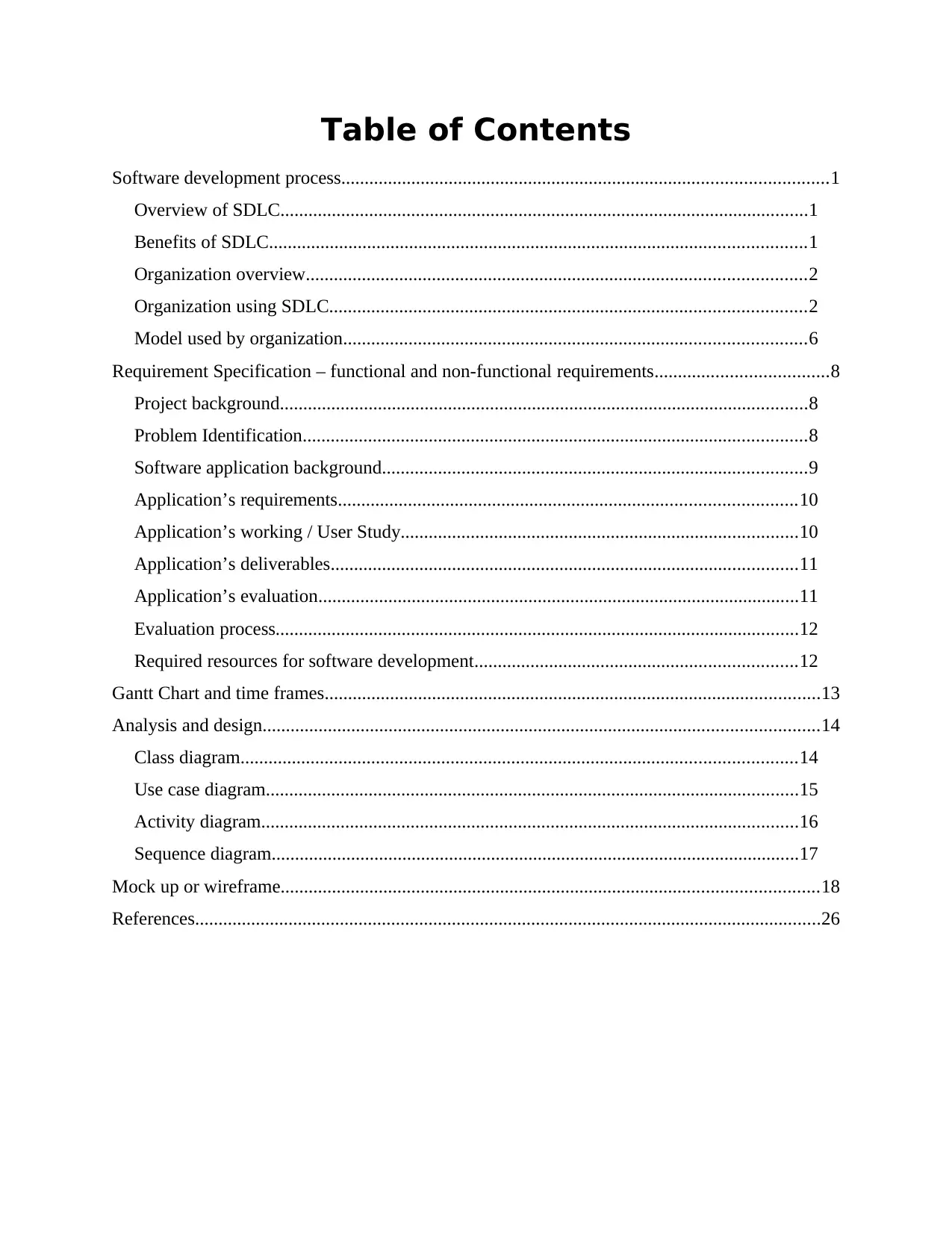
Table of Contents
Software development process........................................................................................................1
Overview of SDLC.................................................................................................................1
Benefits of SDLC...................................................................................................................1
Organization overview...........................................................................................................2
Organization using SDLC......................................................................................................2
Model used by organization...................................................................................................6
Requirement Specification – functional and non-functional requirements.....................................8
Project background.................................................................................................................8
Problem Identification............................................................................................................8
Software application background...........................................................................................9
Application’s requirements..................................................................................................10
Application’s working / User Study.....................................................................................10
Application’s deliverables....................................................................................................11
Application’s evaluation.......................................................................................................11
Evaluation process................................................................................................................12
Required resources for software development.....................................................................12
Gantt Chart and time frames..........................................................................................................13
Analysis and design.......................................................................................................................14
Class diagram.......................................................................................................................14
Use case diagram..................................................................................................................15
Activity diagram...................................................................................................................16
Sequence diagram.................................................................................................................17
Mock up or wireframe...................................................................................................................18
References......................................................................................................................................26
Software development process........................................................................................................1
Overview of SDLC.................................................................................................................1
Benefits of SDLC...................................................................................................................1
Organization overview...........................................................................................................2
Organization using SDLC......................................................................................................2
Model used by organization...................................................................................................6
Requirement Specification – functional and non-functional requirements.....................................8
Project background.................................................................................................................8
Problem Identification............................................................................................................8
Software application background...........................................................................................9
Application’s requirements..................................................................................................10
Application’s working / User Study.....................................................................................10
Application’s deliverables....................................................................................................11
Application’s evaluation.......................................................................................................11
Evaluation process................................................................................................................12
Required resources for software development.....................................................................12
Gantt Chart and time frames..........................................................................................................13
Analysis and design.......................................................................................................................14
Class diagram.......................................................................................................................14
Use case diagram..................................................................................................................15
Activity diagram...................................................................................................................16
Sequence diagram.................................................................................................................17
Mock up or wireframe...................................................................................................................18
References......................................................................................................................................26
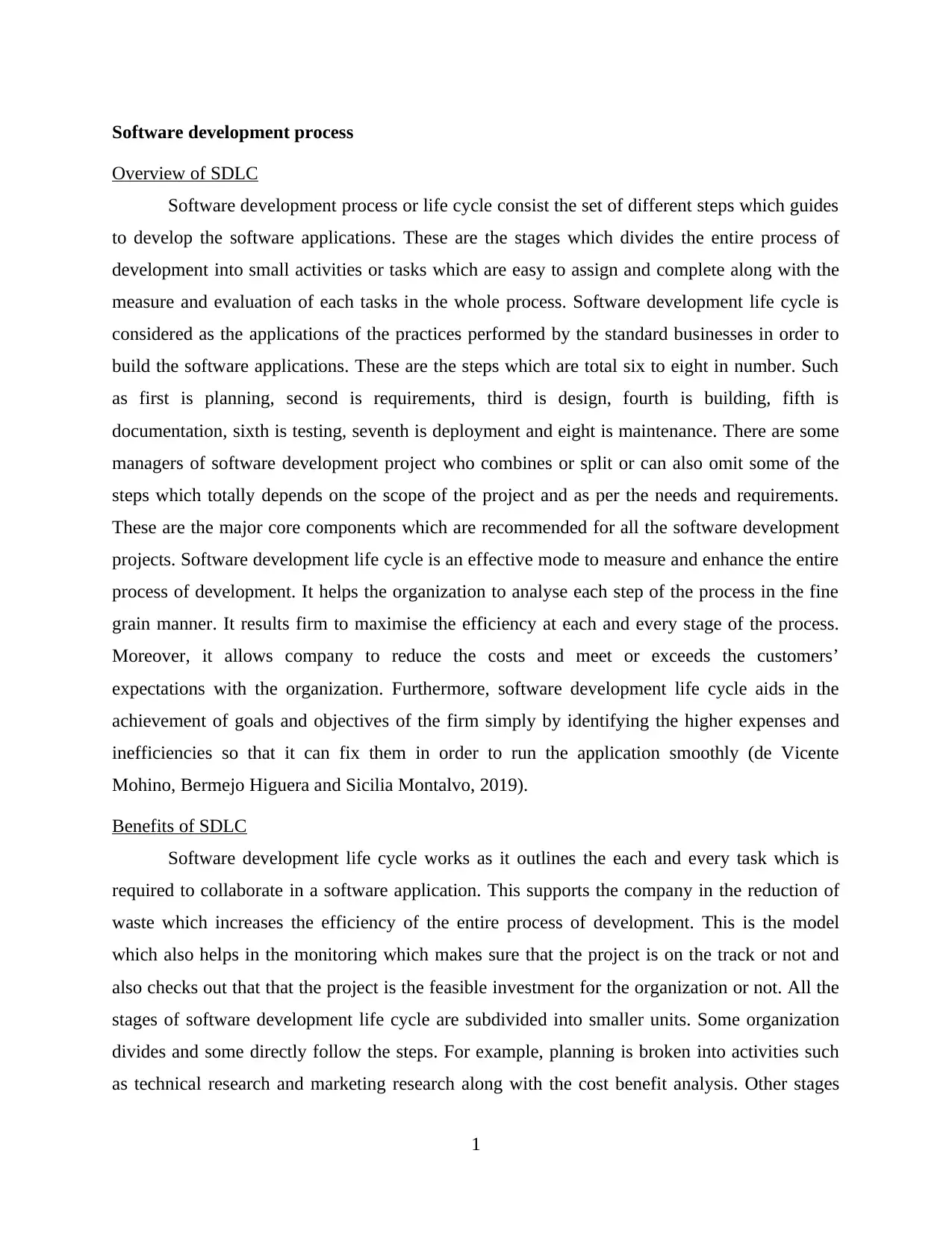
Software development process
Overview of SDLC
Software development process or life cycle consist the set of different steps which guides
to develop the software applications. These are the stages which divides the entire process of
development into small activities or tasks which are easy to assign and complete along with the
measure and evaluation of each tasks in the whole process. Software development life cycle is
considered as the applications of the practices performed by the standard businesses in order to
build the software applications. These are the steps which are total six to eight in number. Such
as first is planning, second is requirements, third is design, fourth is building, fifth is
documentation, sixth is testing, seventh is deployment and eight is maintenance. There are some
managers of software development project who combines or split or can also omit some of the
steps which totally depends on the scope of the project and as per the needs and requirements.
These are the major core components which are recommended for all the software development
projects. Software development life cycle is an effective mode to measure and enhance the entire
process of development. It helps the organization to analyse each step of the process in the fine
grain manner. It results firm to maximise the efficiency at each and every stage of the process.
Moreover, it allows company to reduce the costs and meet or exceeds the customers’
expectations with the organization. Furthermore, software development life cycle aids in the
achievement of goals and objectives of the firm simply by identifying the higher expenses and
inefficiencies so that it can fix them in order to run the application smoothly (de Vicente
Mohino, Bermejo Higuera and Sicilia Montalvo, 2019).
Benefits of SDLC
Software development life cycle works as it outlines the each and every task which is
required to collaborate in a software application. This supports the company in the reduction of
waste which increases the efficiency of the entire process of development. This is the model
which also helps in the monitoring which makes sure that the project is on the track or not and
also checks out that that the project is the feasible investment for the organization or not. All the
stages of software development life cycle are subdivided into smaller units. Some organization
divides and some directly follow the steps. For example, planning is broken into activities such
as technical research and marketing research along with the cost benefit analysis. Other stages
1
Overview of SDLC
Software development process or life cycle consist the set of different steps which guides
to develop the software applications. These are the stages which divides the entire process of
development into small activities or tasks which are easy to assign and complete along with the
measure and evaluation of each tasks in the whole process. Software development life cycle is
considered as the applications of the practices performed by the standard businesses in order to
build the software applications. These are the steps which are total six to eight in number. Such
as first is planning, second is requirements, third is design, fourth is building, fifth is
documentation, sixth is testing, seventh is deployment and eight is maintenance. There are some
managers of software development project who combines or split or can also omit some of the
steps which totally depends on the scope of the project and as per the needs and requirements.
These are the major core components which are recommended for all the software development
projects. Software development life cycle is an effective mode to measure and enhance the entire
process of development. It helps the organization to analyse each step of the process in the fine
grain manner. It results firm to maximise the efficiency at each and every stage of the process.
Moreover, it allows company to reduce the costs and meet or exceeds the customers’
expectations with the organization. Furthermore, software development life cycle aids in the
achievement of goals and objectives of the firm simply by identifying the higher expenses and
inefficiencies so that it can fix them in order to run the application smoothly (de Vicente
Mohino, Bermejo Higuera and Sicilia Montalvo, 2019).
Benefits of SDLC
Software development life cycle works as it outlines the each and every task which is
required to collaborate in a software application. This supports the company in the reduction of
waste which increases the efficiency of the entire process of development. This is the model
which also helps in the monitoring which makes sure that the project is on the track or not and
also checks out that that the project is the feasible investment for the organization or not. All the
stages of software development life cycle are subdivided into smaller units. Some organization
divides and some directly follow the steps. For example, planning is broken into activities such
as technical research and marketing research along with the cost benefit analysis. Other stages
1
⊘ This is a preview!⊘
Do you want full access?
Subscribe today to unlock all pages.

Trusted by 1+ million students worldwide
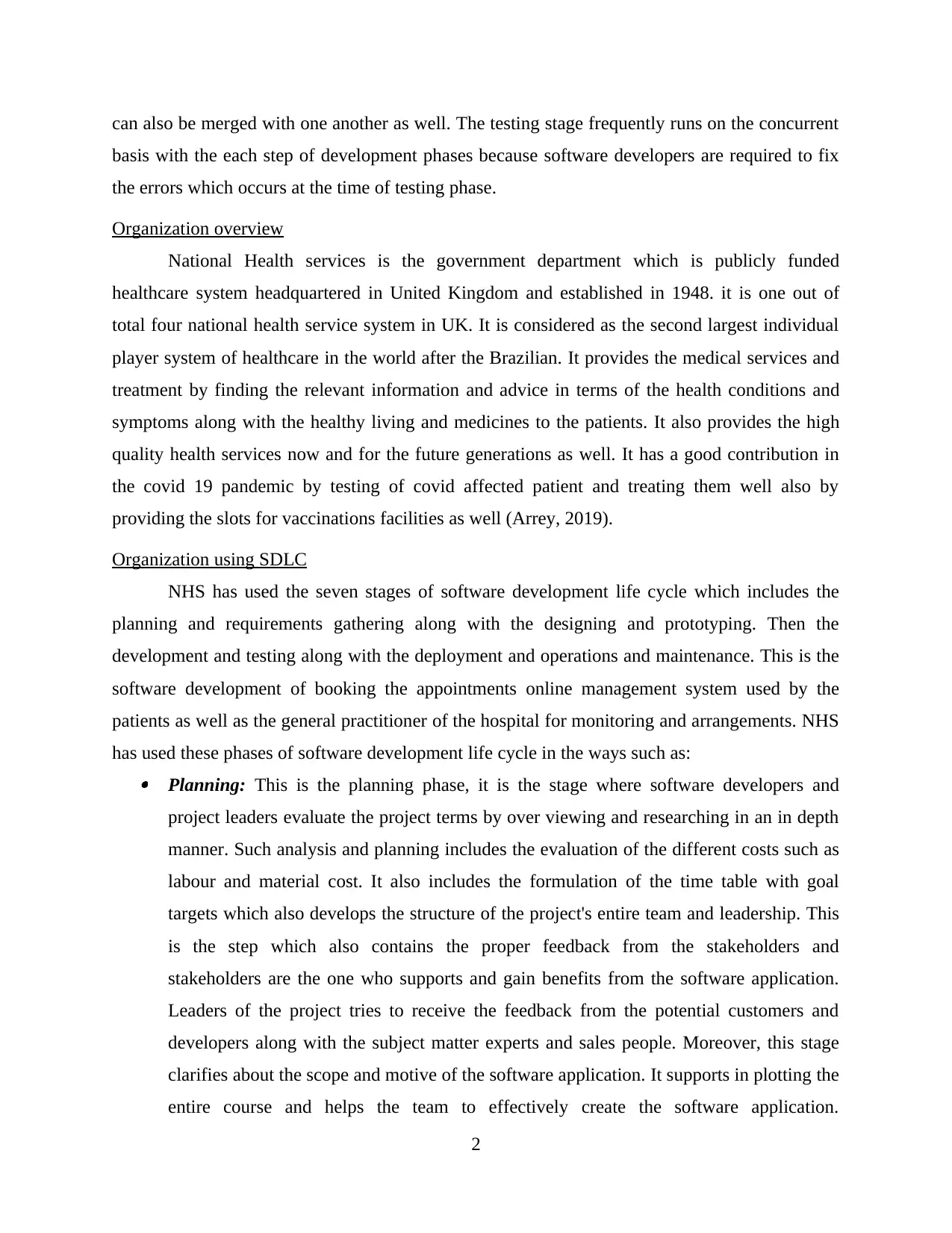
can also be merged with one another as well. The testing stage frequently runs on the concurrent
basis with the each step of development phases because software developers are required to fix
the errors which occurs at the time of testing phase.
Organization overview
National Health services is the government department which is publicly funded
healthcare system headquartered in United Kingdom and established in 1948. it is one out of
total four national health service system in UK. It is considered as the second largest individual
player system of healthcare in the world after the Brazilian. It provides the medical services and
treatment by finding the relevant information and advice in terms of the health conditions and
symptoms along with the healthy living and medicines to the patients. It also provides the high
quality health services now and for the future generations as well. It has a good contribution in
the covid 19 pandemic by testing of covid affected patient and treating them well also by
providing the slots for vaccinations facilities as well (Arrey, 2019).
Organization using SDLC
NHS has used the seven stages of software development life cycle which includes the
planning and requirements gathering along with the designing and prototyping. Then the
development and testing along with the deployment and operations and maintenance. This is the
software development of booking the appointments online management system used by the
patients as well as the general practitioner of the hospital for monitoring and arrangements. NHS
has used these phases of software development life cycle in the ways such as: Planning: This is the planning phase, it is the stage where software developers and
project leaders evaluate the project terms by over viewing and researching in an in depth
manner. Such analysis and planning includes the evaluation of the different costs such as
labour and material cost. It also includes the formulation of the time table with goal
targets which also develops the structure of the project's entire team and leadership. This
is the step which also contains the proper feedback from the stakeholders and
stakeholders are the one who supports and gain benefits from the software application.
Leaders of the project tries to receive the feedback from the potential customers and
developers along with the subject matter experts and sales people. Moreover, this stage
clarifies about the scope and motive of the software application. It supports in plotting the
entire course and helps the team to effectively create the software application.
2
basis with the each step of development phases because software developers are required to fix
the errors which occurs at the time of testing phase.
Organization overview
National Health services is the government department which is publicly funded
healthcare system headquartered in United Kingdom and established in 1948. it is one out of
total four national health service system in UK. It is considered as the second largest individual
player system of healthcare in the world after the Brazilian. It provides the medical services and
treatment by finding the relevant information and advice in terms of the health conditions and
symptoms along with the healthy living and medicines to the patients. It also provides the high
quality health services now and for the future generations as well. It has a good contribution in
the covid 19 pandemic by testing of covid affected patient and treating them well also by
providing the slots for vaccinations facilities as well (Arrey, 2019).
Organization using SDLC
NHS has used the seven stages of software development life cycle which includes the
planning and requirements gathering along with the designing and prototyping. Then the
development and testing along with the deployment and operations and maintenance. This is the
software development of booking the appointments online management system used by the
patients as well as the general practitioner of the hospital for monitoring and arrangements. NHS
has used these phases of software development life cycle in the ways such as: Planning: This is the planning phase, it is the stage where software developers and
project leaders evaluate the project terms by over viewing and researching in an in depth
manner. Such analysis and planning includes the evaluation of the different costs such as
labour and material cost. It also includes the formulation of the time table with goal
targets which also develops the structure of the project's entire team and leadership. This
is the step which also contains the proper feedback from the stakeholders and
stakeholders are the one who supports and gain benefits from the software application.
Leaders of the project tries to receive the feedback from the potential customers and
developers along with the subject matter experts and sales people. Moreover, this stage
clarifies about the scope and motive of the software application. It supports in plotting the
entire course and helps the team to effectively create the software application.
2
Paraphrase This Document
Need a fresh take? Get an instant paraphrase of this document with our AI Paraphraser
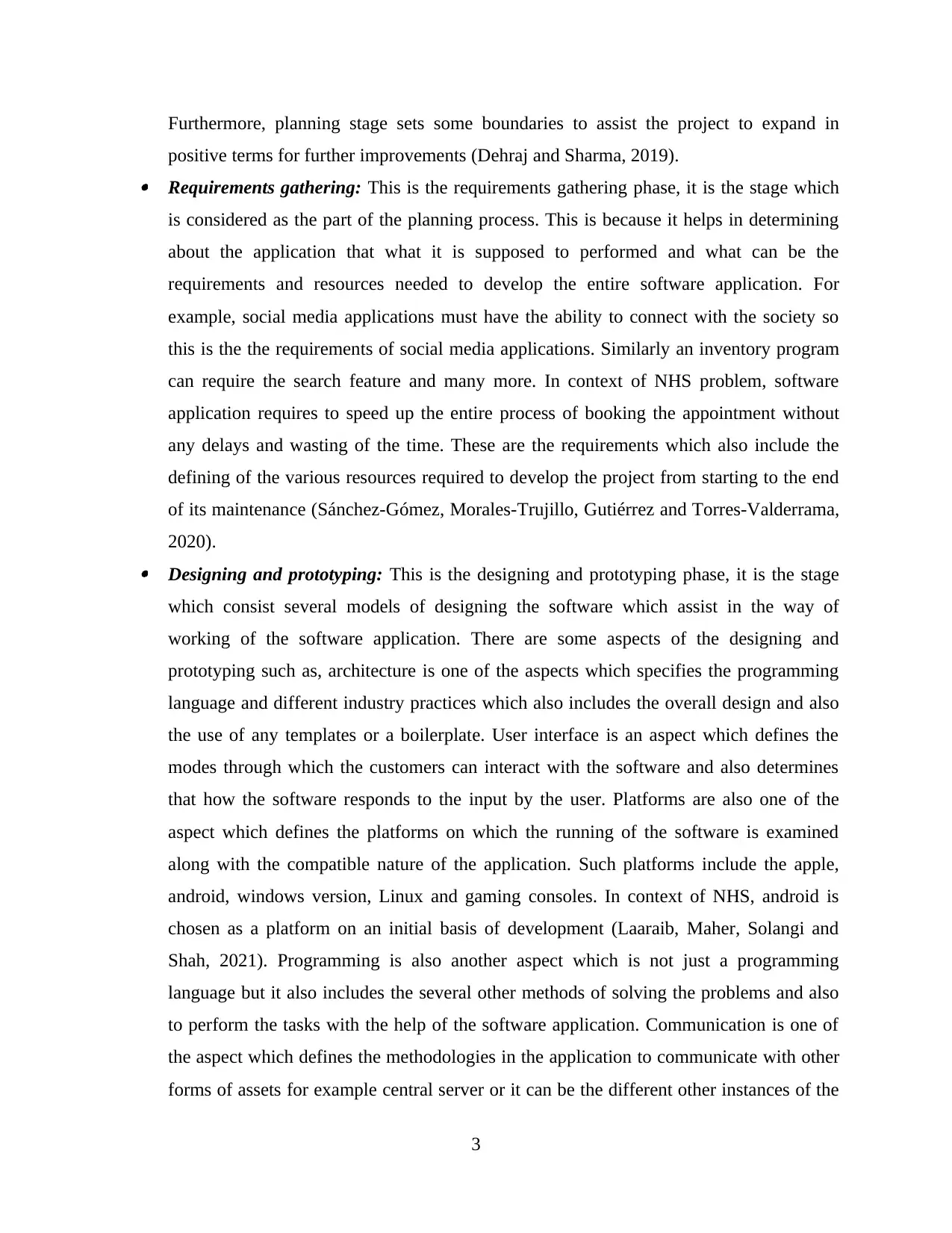
Furthermore, planning stage sets some boundaries to assist the project to expand in
positive terms for further improvements (Dehraj and Sharma, 2019). Requirements gathering: This is the requirements gathering phase, it is the stage which
is considered as the part of the planning process. This is because it helps in determining
about the application that what it is supposed to performed and what can be the
requirements and resources needed to develop the entire software application. For
example, social media applications must have the ability to connect with the society so
this is the the requirements of social media applications. Similarly an inventory program
can require the search feature and many more. In context of NHS problem, software
application requires to speed up the entire process of booking the appointment without
any delays and wasting of the time. These are the requirements which also include the
defining of the various resources required to develop the project from starting to the end
of its maintenance (Sánchez-Gómez, Morales-Trujillo, Gutiérrez and Torres-Valderrama,
2020). Designing and prototyping: This is the designing and prototyping phase, it is the stage
which consist several models of designing the software which assist in the way of
working of the software application. There are some aspects of the designing and
prototyping such as, architecture is one of the aspects which specifies the programming
language and different industry practices which also includes the overall design and also
the use of any templates or a boilerplate. User interface is an aspect which defines the
modes through which the customers can interact with the software and also determines
that how the software responds to the input by the user. Platforms are also one of the
aspect which defines the platforms on which the running of the software is examined
along with the compatible nature of the application. Such platforms include the apple,
android, windows version, Linux and gaming consoles. In context of NHS, android is
chosen as a platform on an initial basis of development (Laaraib, Maher, Solangi and
Shah, 2021). Programming is also another aspect which is not just a programming
language but it also includes the several other methods of solving the problems and also
to perform the tasks with the help of the software application. Communication is one of
the aspect which defines the methodologies in the application to communicate with other
forms of assets for example central server or it can be the different other instances of the
3
positive terms for further improvements (Dehraj and Sharma, 2019). Requirements gathering: This is the requirements gathering phase, it is the stage which
is considered as the part of the planning process. This is because it helps in determining
about the application that what it is supposed to performed and what can be the
requirements and resources needed to develop the entire software application. For
example, social media applications must have the ability to connect with the society so
this is the the requirements of social media applications. Similarly an inventory program
can require the search feature and many more. In context of NHS problem, software
application requires to speed up the entire process of booking the appointment without
any delays and wasting of the time. These are the requirements which also include the
defining of the various resources required to develop the project from starting to the end
of its maintenance (Sánchez-Gómez, Morales-Trujillo, Gutiérrez and Torres-Valderrama,
2020). Designing and prototyping: This is the designing and prototyping phase, it is the stage
which consist several models of designing the software which assist in the way of
working of the software application. There are some aspects of the designing and
prototyping such as, architecture is one of the aspects which specifies the programming
language and different industry practices which also includes the overall design and also
the use of any templates or a boilerplate. User interface is an aspect which defines the
modes through which the customers can interact with the software and also determines
that how the software responds to the input by the user. Platforms are also one of the
aspect which defines the platforms on which the running of the software is examined
along with the compatible nature of the application. Such platforms include the apple,
android, windows version, Linux and gaming consoles. In context of NHS, android is
chosen as a platform on an initial basis of development (Laaraib, Maher, Solangi and
Shah, 2021). Programming is also another aspect which is not just a programming
language but it also includes the several other methods of solving the problems and also
to perform the tasks with the help of the software application. Communication is one of
the aspect which defines the methodologies in the application to communicate with other
forms of assets for example central server or it can be the different other instances of the
3
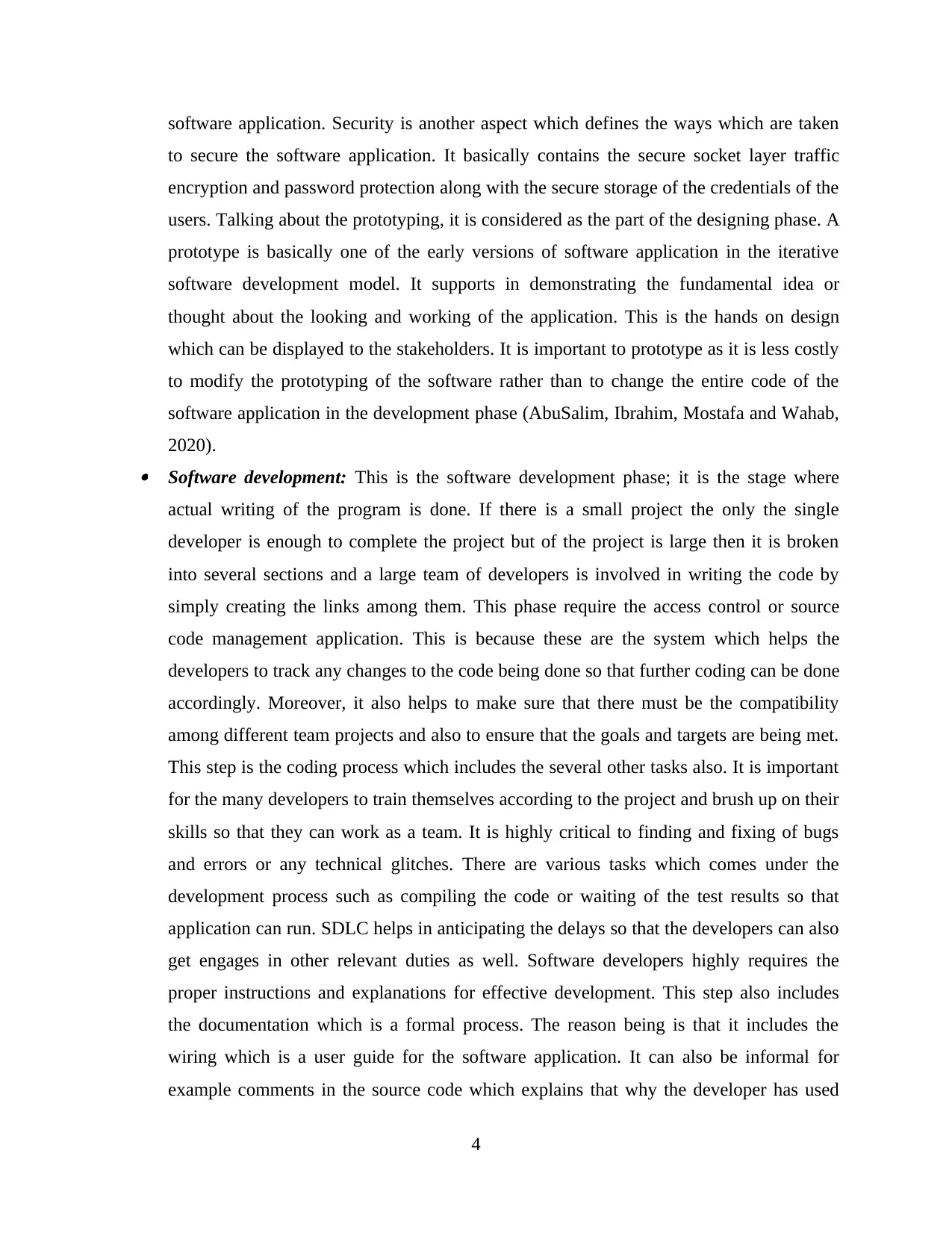
software application. Security is another aspect which defines the ways which are taken
to secure the software application. It basically contains the secure socket layer traffic
encryption and password protection along with the secure storage of the credentials of the
users. Talking about the prototyping, it is considered as the part of the designing phase. A
prototype is basically one of the early versions of software application in the iterative
software development model. It supports in demonstrating the fundamental idea or
thought about the looking and working of the application. This is the hands on design
which can be displayed to the stakeholders. It is important to prototype as it is less costly
to modify the prototyping of the software rather than to change the entire code of the
software application in the development phase (AbuSalim, Ibrahim, Mostafa and Wahab,
2020). Software development: This is the software development phase; it is the stage where
actual writing of the program is done. If there is a small project the only the single
developer is enough to complete the project but of the project is large then it is broken
into several sections and a large team of developers is involved in writing the code by
simply creating the links among them. This phase require the access control or source
code management application. This is because these are the system which helps the
developers to track any changes to the code being done so that further coding can be done
accordingly. Moreover, it also helps to make sure that there must be the compatibility
among different team projects and also to ensure that the goals and targets are being met.
This step is the coding process which includes the several other tasks also. It is important
for the many developers to train themselves according to the project and brush up on their
skills so that they can work as a team. It is highly critical to finding and fixing of bugs
and errors or any technical glitches. There are various tasks which comes under the
development process such as compiling the code or waiting of the test results so that
application can run. SDLC helps in anticipating the delays so that the developers can also
get engages in other relevant duties as well. Software developers highly requires the
proper instructions and explanations for effective development. This step also includes
the documentation which is a formal process. The reason being is that it includes the
wiring which is a user guide for the software application. It can also be informal for
example comments in the source code which explains that why the developer has used
4
to secure the software application. It basically contains the secure socket layer traffic
encryption and password protection along with the secure storage of the credentials of the
users. Talking about the prototyping, it is considered as the part of the designing phase. A
prototype is basically one of the early versions of software application in the iterative
software development model. It supports in demonstrating the fundamental idea or
thought about the looking and working of the application. This is the hands on design
which can be displayed to the stakeholders. It is important to prototype as it is less costly
to modify the prototyping of the software rather than to change the entire code of the
software application in the development phase (AbuSalim, Ibrahim, Mostafa and Wahab,
2020). Software development: This is the software development phase; it is the stage where
actual writing of the program is done. If there is a small project the only the single
developer is enough to complete the project but of the project is large then it is broken
into several sections and a large team of developers is involved in writing the code by
simply creating the links among them. This phase require the access control or source
code management application. This is because these are the system which helps the
developers to track any changes to the code being done so that further coding can be done
accordingly. Moreover, it also helps to make sure that there must be the compatibility
among different team projects and also to ensure that the goals and targets are being met.
This step is the coding process which includes the several other tasks also. It is important
for the many developers to train themselves according to the project and brush up on their
skills so that they can work as a team. It is highly critical to finding and fixing of bugs
and errors or any technical glitches. There are various tasks which comes under the
development process such as compiling the code or waiting of the test results so that
application can run. SDLC helps in anticipating the delays so that the developers can also
get engages in other relevant duties as well. Software developers highly requires the
proper instructions and explanations for effective development. This step also includes
the documentation which is a formal process. The reason being is that it includes the
wiring which is a user guide for the software application. It can also be informal for
example comments in the source code which explains that why the developer has used
4
⊘ This is a preview!⊘
Do you want full access?
Subscribe today to unlock all pages.

Trusted by 1+ million students worldwide
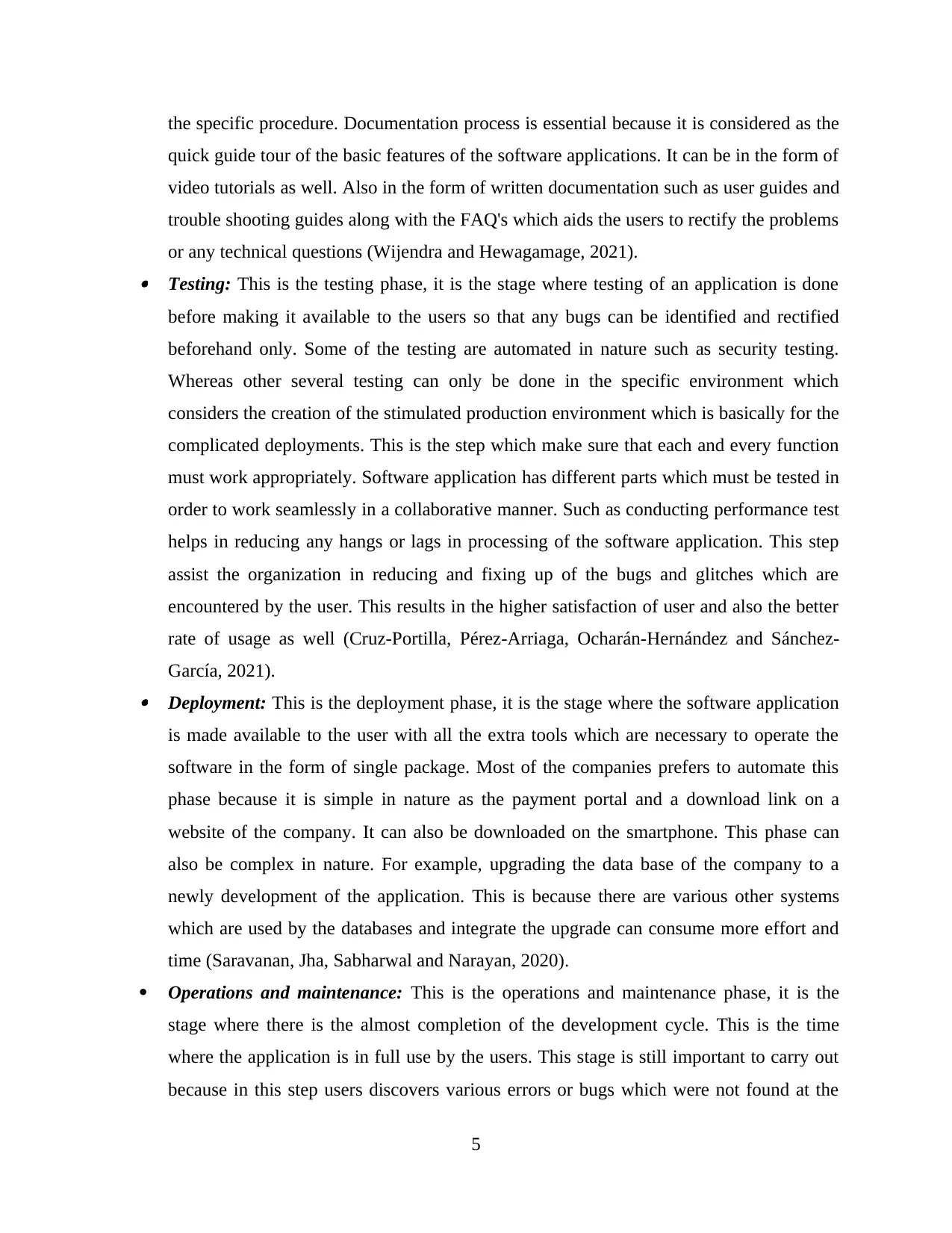
the specific procedure. Documentation process is essential because it is considered as the
quick guide tour of the basic features of the software applications. It can be in the form of
video tutorials as well. Also in the form of written documentation such as user guides and
trouble shooting guides along with the FAQ's which aids the users to rectify the problems
or any technical questions (Wijendra and Hewagamage, 2021). Testing: This is the testing phase, it is the stage where testing of an application is done
before making it available to the users so that any bugs can be identified and rectified
beforehand only. Some of the testing are automated in nature such as security testing.
Whereas other several testing can only be done in the specific environment which
considers the creation of the stimulated production environment which is basically for the
complicated deployments. This is the step which make sure that each and every function
must work appropriately. Software application has different parts which must be tested in
order to work seamlessly in a collaborative manner. Such as conducting performance test
helps in reducing any hangs or lags in processing of the software application. This step
assist the organization in reducing and fixing up of the bugs and glitches which are
encountered by the user. This results in the higher satisfaction of user and also the better
rate of usage as well (Cruz-Portilla, Pérez-Arriaga, Ocharán-Hernández and Sánchez-
García, 2021). Deployment: This is the deployment phase, it is the stage where the software application
is made available to the user with all the extra tools which are necessary to operate the
software in the form of single package. Most of the companies prefers to automate this
phase because it is simple in nature as the payment portal and a download link on a
website of the company. It can also be downloaded on the smartphone. This phase can
also be complex in nature. For example, upgrading the data base of the company to a
newly development of the application. This is because there are various other systems
which are used by the databases and integrate the upgrade can consume more effort and
time (Saravanan, Jha, Sabharwal and Narayan, 2020).
Operations and maintenance: This is the operations and maintenance phase, it is the
stage where there is the almost completion of the development cycle. This is the time
where the application is in full use by the users. This stage is still important to carry out
because in this step users discovers various errors or bugs which were not found at the
5
quick guide tour of the basic features of the software applications. It can be in the form of
video tutorials as well. Also in the form of written documentation such as user guides and
trouble shooting guides along with the FAQ's which aids the users to rectify the problems
or any technical questions (Wijendra and Hewagamage, 2021). Testing: This is the testing phase, it is the stage where testing of an application is done
before making it available to the users so that any bugs can be identified and rectified
beforehand only. Some of the testing are automated in nature such as security testing.
Whereas other several testing can only be done in the specific environment which
considers the creation of the stimulated production environment which is basically for the
complicated deployments. This is the step which make sure that each and every function
must work appropriately. Software application has different parts which must be tested in
order to work seamlessly in a collaborative manner. Such as conducting performance test
helps in reducing any hangs or lags in processing of the software application. This step
assist the organization in reducing and fixing up of the bugs and glitches which are
encountered by the user. This results in the higher satisfaction of user and also the better
rate of usage as well (Cruz-Portilla, Pérez-Arriaga, Ocharán-Hernández and Sánchez-
García, 2021). Deployment: This is the deployment phase, it is the stage where the software application
is made available to the user with all the extra tools which are necessary to operate the
software in the form of single package. Most of the companies prefers to automate this
phase because it is simple in nature as the payment portal and a download link on a
website of the company. It can also be downloaded on the smartphone. This phase can
also be complex in nature. For example, upgrading the data base of the company to a
newly development of the application. This is because there are various other systems
which are used by the databases and integrate the upgrade can consume more effort and
time (Saravanan, Jha, Sabharwal and Narayan, 2020).
Operations and maintenance: This is the operations and maintenance phase, it is the
stage where there is the almost completion of the development cycle. This is the time
where the application is in full use by the users. This stage is still important to carry out
because in this step users discovers various errors or bugs which were not found at the
5
Paraphrase This Document
Need a fresh take? Get an instant paraphrase of this document with our AI Paraphraser
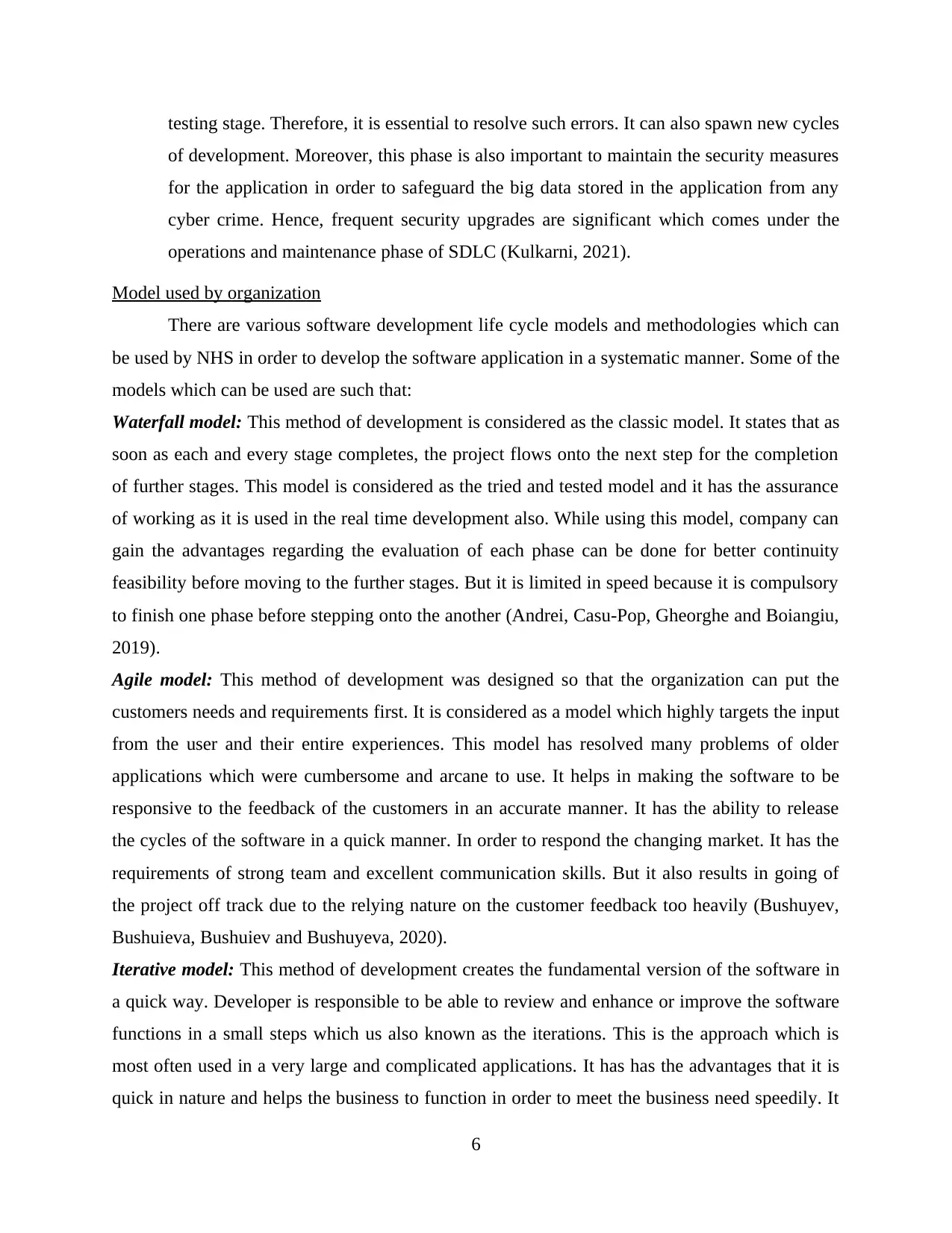
testing stage. Therefore, it is essential to resolve such errors. It can also spawn new cycles
of development. Moreover, this phase is also important to maintain the security measures
for the application in order to safeguard the big data stored in the application from any
cyber crime. Hence, frequent security upgrades are significant which comes under the
operations and maintenance phase of SDLC (Kulkarni, 2021).
Model used by organization
There are various software development life cycle models and methodologies which can
be used by NHS in order to develop the software application in a systematic manner. Some of the
models which can be used are such that:
Waterfall model: This method of development is considered as the classic model. It states that as
soon as each and every stage completes, the project flows onto the next step for the completion
of further stages. This model is considered as the tried and tested model and it has the assurance
of working as it is used in the real time development also. While using this model, company can
gain the advantages regarding the evaluation of each phase can be done for better continuity
feasibility before moving to the further stages. But it is limited in speed because it is compulsory
to finish one phase before stepping onto the another (Andrei, Casu-Pop, Gheorghe and Boiangiu,
2019).
Agile model: This method of development was designed so that the organization can put the
customers needs and requirements first. It is considered as a model which highly targets the input
from the user and their entire experiences. This model has resolved many problems of older
applications which were cumbersome and arcane to use. It helps in making the software to be
responsive to the feedback of the customers in an accurate manner. It has the ability to release
the cycles of the software in a quick manner. In order to respond the changing market. It has the
requirements of strong team and excellent communication skills. But it also results in going of
the project off track due to the relying nature on the customer feedback too heavily (Bushuyev,
Bushuieva, Bushuiev and Bushuyeva, 2020).
Iterative model: This method of development creates the fundamental version of the software in
a quick way. Developer is responsible to be able to review and enhance or improve the software
functions in a small steps which us also known as the iterations. This is the approach which is
most often used in a very large and complicated applications. It has has the advantages that it is
quick in nature and helps the business to function in order to meet the business need speedily. It
6
of development. Moreover, this phase is also important to maintain the security measures
for the application in order to safeguard the big data stored in the application from any
cyber crime. Hence, frequent security upgrades are significant which comes under the
operations and maintenance phase of SDLC (Kulkarni, 2021).
Model used by organization
There are various software development life cycle models and methodologies which can
be used by NHS in order to develop the software application in a systematic manner. Some of the
models which can be used are such that:
Waterfall model: This method of development is considered as the classic model. It states that as
soon as each and every stage completes, the project flows onto the next step for the completion
of further stages. This model is considered as the tried and tested model and it has the assurance
of working as it is used in the real time development also. While using this model, company can
gain the advantages regarding the evaluation of each phase can be done for better continuity
feasibility before moving to the further stages. But it is limited in speed because it is compulsory
to finish one phase before stepping onto the another (Andrei, Casu-Pop, Gheorghe and Boiangiu,
2019).
Agile model: This method of development was designed so that the organization can put the
customers needs and requirements first. It is considered as a model which highly targets the input
from the user and their entire experiences. This model has resolved many problems of older
applications which were cumbersome and arcane to use. It helps in making the software to be
responsive to the feedback of the customers in an accurate manner. It has the ability to release
the cycles of the software in a quick manner. In order to respond the changing market. It has the
requirements of strong team and excellent communication skills. But it also results in going of
the project off track due to the relying nature on the customer feedback too heavily (Bushuyev,
Bushuieva, Bushuiev and Bushuyeva, 2020).
Iterative model: This method of development creates the fundamental version of the software in
a quick way. Developer is responsible to be able to review and enhance or improve the software
functions in a small steps which us also known as the iterations. This is the approach which is
most often used in a very large and complicated applications. It has has the advantages that it is
quick in nature and helps the business to function in order to meet the business need speedily. It
6
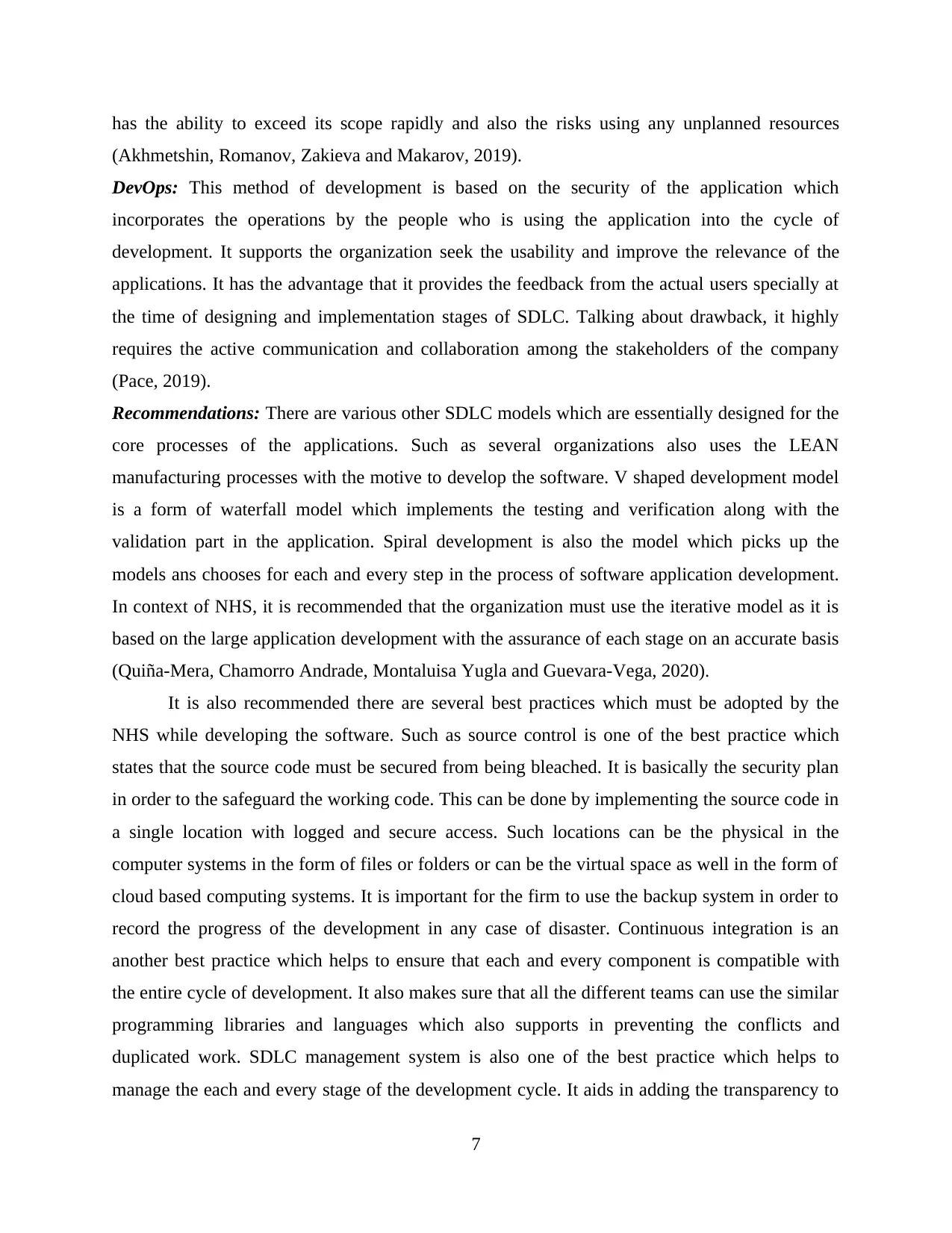
has the ability to exceed its scope rapidly and also the risks using any unplanned resources
(Akhmetshin, Romanov, Zakieva and Makarov, 2019).
DevOps: This method of development is based on the security of the application which
incorporates the operations by the people who is using the application into the cycle of
development. It supports the organization seek the usability and improve the relevance of the
applications. It has the advantage that it provides the feedback from the actual users specially at
the time of designing and implementation stages of SDLC. Talking about drawback, it highly
requires the active communication and collaboration among the stakeholders of the company
(Pace, 2019).
Recommendations: There are various other SDLC models which are essentially designed for the
core processes of the applications. Such as several organizations also uses the LEAN
manufacturing processes with the motive to develop the software. V shaped development model
is a form of waterfall model which implements the testing and verification along with the
validation part in the application. Spiral development is also the model which picks up the
models ans chooses for each and every step in the process of software application development.
In context of NHS, it is recommended that the organization must use the iterative model as it is
based on the large application development with the assurance of each stage on an accurate basis
(Quiña-Mera, Chamorro Andrade, Montaluisa Yugla and Guevara-Vega, 2020).
It is also recommended there are several best practices which must be adopted by the
NHS while developing the software. Such as source control is one of the best practice which
states that the source code must be secured from being bleached. It is basically the security plan
in order to the safeguard the working code. This can be done by implementing the source code in
a single location with logged and secure access. Such locations can be the physical in the
computer systems in the form of files or folders or can be the virtual space as well in the form of
cloud based computing systems. It is important for the firm to use the backup system in order to
record the progress of the development in any case of disaster. Continuous integration is an
another best practice which helps to ensure that each and every component is compatible with
the entire cycle of development. It also makes sure that all the different teams can use the similar
programming libraries and languages which also supports in preventing the conflicts and
duplicated work. SDLC management system is also one of the best practice which helps to
manage the each and every stage of the development cycle. It aids in adding the transparency to
7
(Akhmetshin, Romanov, Zakieva and Makarov, 2019).
DevOps: This method of development is based on the security of the application which
incorporates the operations by the people who is using the application into the cycle of
development. It supports the organization seek the usability and improve the relevance of the
applications. It has the advantage that it provides the feedback from the actual users specially at
the time of designing and implementation stages of SDLC. Talking about drawback, it highly
requires the active communication and collaboration among the stakeholders of the company
(Pace, 2019).
Recommendations: There are various other SDLC models which are essentially designed for the
core processes of the applications. Such as several organizations also uses the LEAN
manufacturing processes with the motive to develop the software. V shaped development model
is a form of waterfall model which implements the testing and verification along with the
validation part in the application. Spiral development is also the model which picks up the
models ans chooses for each and every step in the process of software application development.
In context of NHS, it is recommended that the organization must use the iterative model as it is
based on the large application development with the assurance of each stage on an accurate basis
(Quiña-Mera, Chamorro Andrade, Montaluisa Yugla and Guevara-Vega, 2020).
It is also recommended there are several best practices which must be adopted by the
NHS while developing the software. Such as source control is one of the best practice which
states that the source code must be secured from being bleached. It is basically the security plan
in order to the safeguard the working code. This can be done by implementing the source code in
a single location with logged and secure access. Such locations can be the physical in the
computer systems in the form of files or folders or can be the virtual space as well in the form of
cloud based computing systems. It is important for the firm to use the backup system in order to
record the progress of the development in any case of disaster. Continuous integration is an
another best practice which helps to ensure that each and every component is compatible with
the entire cycle of development. It also makes sure that all the different teams can use the similar
programming libraries and languages which also supports in preventing the conflicts and
duplicated work. SDLC management system is also one of the best practice which helps to
manage the each and every stage of the development cycle. It aids in adding the transparency to
7
⊘ This is a preview!⊘
Do you want full access?
Subscribe today to unlock all pages.

Trusted by 1+ million students worldwide
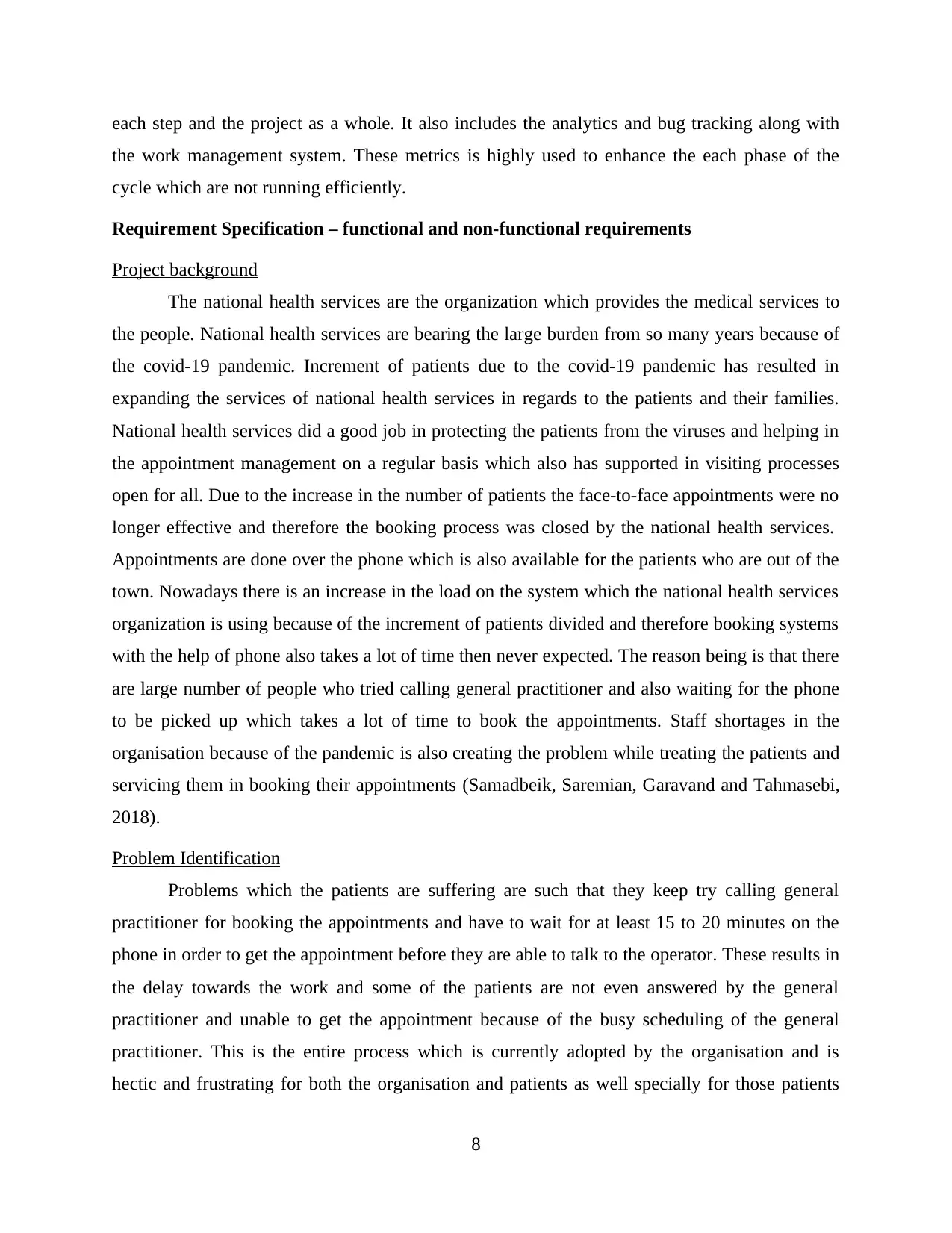
each step and the project as a whole. It also includes the analytics and bug tracking along with
the work management system. These metrics is highly used to enhance the each phase of the
cycle which are not running efficiently.
Requirement Specification – functional and non-functional requirements
Project background
The national health services are the organization which provides the medical services to
the people. National health services are bearing the large burden from so many years because of
the covid-19 pandemic. Increment of patients due to the covid-19 pandemic has resulted in
expanding the services of national health services in regards to the patients and their families.
National health services did a good job in protecting the patients from the viruses and helping in
the appointment management on a regular basis which also has supported in visiting processes
open for all. Due to the increase in the number of patients the face-to-face appointments were no
longer effective and therefore the booking process was closed by the national health services.
Appointments are done over the phone which is also available for the patients who are out of the
town. Nowadays there is an increase in the load on the system which the national health services
organization is using because of the increment of patients divided and therefore booking systems
with the help of phone also takes a lot of time then never expected. The reason being is that there
are large number of people who tried calling general practitioner and also waiting for the phone
to be picked up which takes a lot of time to book the appointments. Staff shortages in the
organisation because of the pandemic is also creating the problem while treating the patients and
servicing them in booking their appointments (Samadbeik, Saremian, Garavand and Tahmasebi,
2018).
Problem Identification
Problems which the patients are suffering are such that they keep try calling general
practitioner for booking the appointments and have to wait for at least 15 to 20 minutes on the
phone in order to get the appointment before they are able to talk to the operator. These results in
the delay towards the work and some of the patients are not even answered by the general
practitioner and unable to get the appointment because of the busy scheduling of the general
practitioner. This is the entire process which is currently adopted by the organisation and is
hectic and frustrating for both the organisation and patients as well specially for those patients
8
the work management system. These metrics is highly used to enhance the each phase of the
cycle which are not running efficiently.
Requirement Specification – functional and non-functional requirements
Project background
The national health services are the organization which provides the medical services to
the people. National health services are bearing the large burden from so many years because of
the covid-19 pandemic. Increment of patients due to the covid-19 pandemic has resulted in
expanding the services of national health services in regards to the patients and their families.
National health services did a good job in protecting the patients from the viruses and helping in
the appointment management on a regular basis which also has supported in visiting processes
open for all. Due to the increase in the number of patients the face-to-face appointments were no
longer effective and therefore the booking process was closed by the national health services.
Appointments are done over the phone which is also available for the patients who are out of the
town. Nowadays there is an increase in the load on the system which the national health services
organization is using because of the increment of patients divided and therefore booking systems
with the help of phone also takes a lot of time then never expected. The reason being is that there
are large number of people who tried calling general practitioner and also waiting for the phone
to be picked up which takes a lot of time to book the appointments. Staff shortages in the
organisation because of the pandemic is also creating the problem while treating the patients and
servicing them in booking their appointments (Samadbeik, Saremian, Garavand and Tahmasebi,
2018).
Problem Identification
Problems which the patients are suffering are such that they keep try calling general
practitioner for booking the appointments and have to wait for at least 15 to 20 minutes on the
phone in order to get the appointment before they are able to talk to the operator. These results in
the delay towards the work and some of the patients are not even answered by the general
practitioner and unable to get the appointment because of the busy scheduling of the general
practitioner. This is the entire process which is currently adopted by the organisation and is
hectic and frustrating for both the organisation and patients as well specially for those patients
8
Paraphrase This Document
Need a fresh take? Get an instant paraphrase of this document with our AI Paraphraser
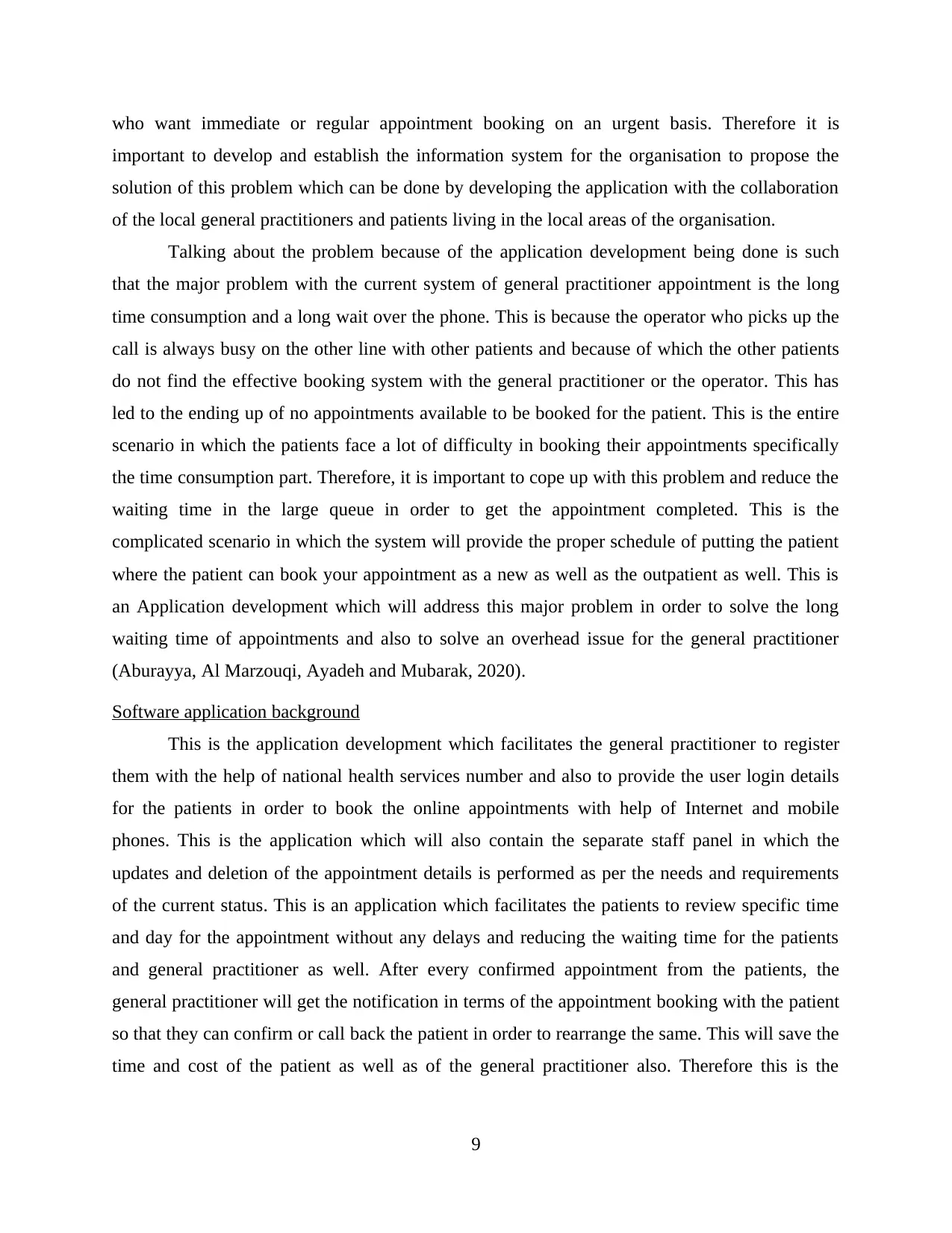
who want immediate or regular appointment booking on an urgent basis. Therefore it is
important to develop and establish the information system for the organisation to propose the
solution of this problem which can be done by developing the application with the collaboration
of the local general practitioners and patients living in the local areas of the organisation.
Talking about the problem because of the application development being done is such
that the major problem with the current system of general practitioner appointment is the long
time consumption and a long wait over the phone. This is because the operator who picks up the
call is always busy on the other line with other patients and because of which the other patients
do not find the effective booking system with the general practitioner or the operator. This has
led to the ending up of no appointments available to be booked for the patient. This is the entire
scenario in which the patients face a lot of difficulty in booking their appointments specifically
the time consumption part. Therefore, it is important to cope up with this problem and reduce the
waiting time in the large queue in order to get the appointment completed. This is the
complicated scenario in which the system will provide the proper schedule of putting the patient
where the patient can book your appointment as a new as well as the outpatient as well. This is
an Application development which will address this major problem in order to solve the long
waiting time of appointments and also to solve an overhead issue for the general practitioner
(Aburayya, Al Marzouqi, Ayadeh and Mubarak, 2020).
Software application background
This is the application development which facilitates the general practitioner to register
them with the help of national health services number and also to provide the user login details
for the patients in order to book the online appointments with help of Internet and mobile
phones. This is the application which will also contain the separate staff panel in which the
updates and deletion of the appointment details is performed as per the needs and requirements
of the current status. This is an application which facilitates the patients to review specific time
and day for the appointment without any delays and reducing the waiting time for the patients
and general practitioner as well. After every confirmed appointment from the patients, the
general practitioner will get the notification in terms of the appointment booking with the patient
so that they can confirm or call back the patient in order to rearrange the same. This will save the
time and cost of the patient as well as of the general practitioner also. Therefore this is the
9
important to develop and establish the information system for the organisation to propose the
solution of this problem which can be done by developing the application with the collaboration
of the local general practitioners and patients living in the local areas of the organisation.
Talking about the problem because of the application development being done is such
that the major problem with the current system of general practitioner appointment is the long
time consumption and a long wait over the phone. This is because the operator who picks up the
call is always busy on the other line with other patients and because of which the other patients
do not find the effective booking system with the general practitioner or the operator. This has
led to the ending up of no appointments available to be booked for the patient. This is the entire
scenario in which the patients face a lot of difficulty in booking their appointments specifically
the time consumption part. Therefore, it is important to cope up with this problem and reduce the
waiting time in the large queue in order to get the appointment completed. This is the
complicated scenario in which the system will provide the proper schedule of putting the patient
where the patient can book your appointment as a new as well as the outpatient as well. This is
an Application development which will address this major problem in order to solve the long
waiting time of appointments and also to solve an overhead issue for the general practitioner
(Aburayya, Al Marzouqi, Ayadeh and Mubarak, 2020).
Software application background
This is the application development which facilitates the general practitioner to register
them with the help of national health services number and also to provide the user login details
for the patients in order to book the online appointments with help of Internet and mobile
phones. This is the application which will also contain the separate staff panel in which the
updates and deletion of the appointment details is performed as per the needs and requirements
of the current status. This is an application which facilitates the patients to review specific time
and day for the appointment without any delays and reducing the waiting time for the patients
and general practitioner as well. After every confirmed appointment from the patients, the
general practitioner will get the notification in terms of the appointment booking with the patient
so that they can confirm or call back the patient in order to rearrange the same. This will save the
time and cost of the patient as well as of the general practitioner also. Therefore this is the
9
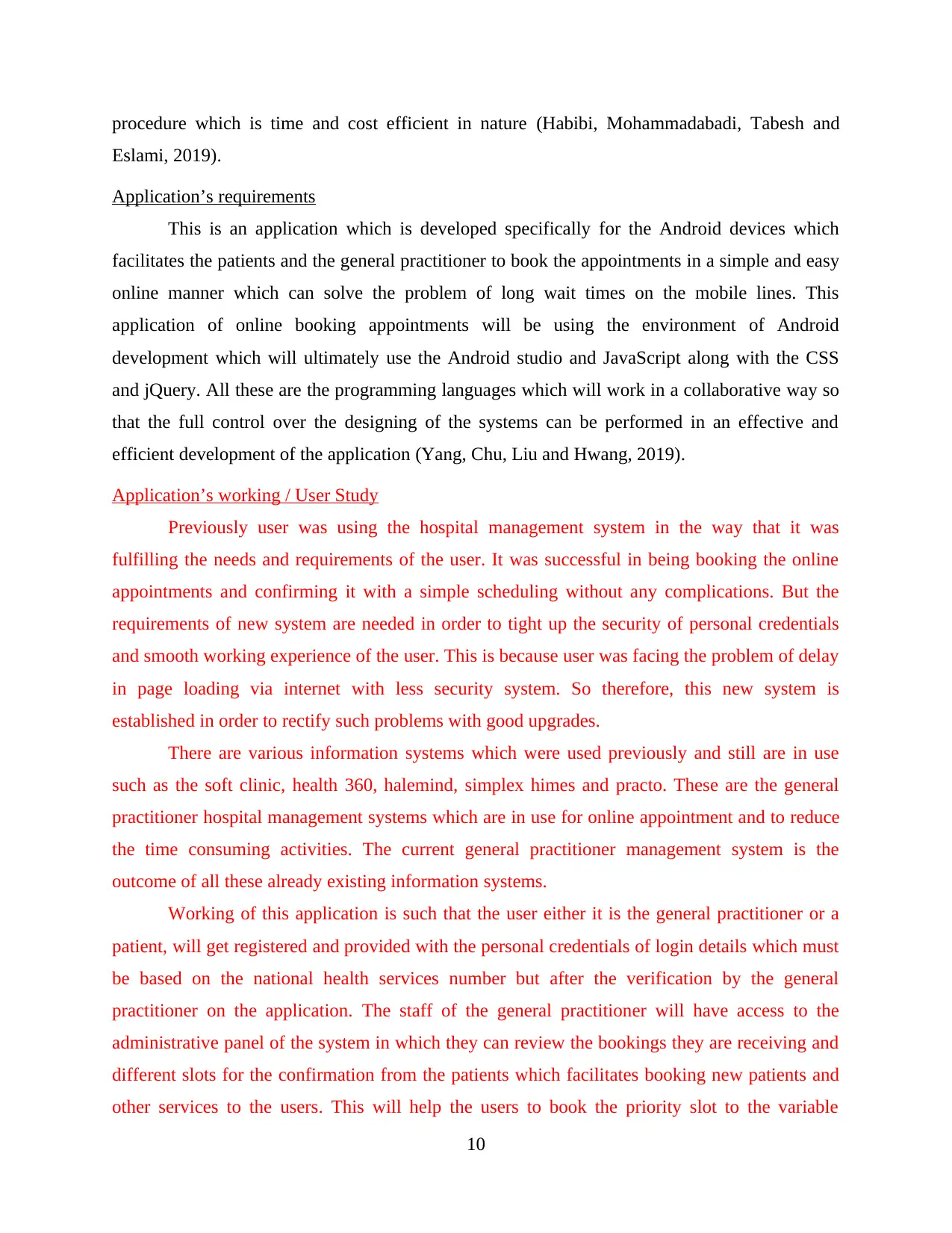
procedure which is time and cost efficient in nature (Habibi, Mohammadabadi, Tabesh and
Eslami, 2019).
Application’s requirements
This is an application which is developed specifically for the Android devices which
facilitates the patients and the general practitioner to book the appointments in a simple and easy
online manner which can solve the problem of long wait times on the mobile lines. This
application of online booking appointments will be using the environment of Android
development which will ultimately use the Android studio and JavaScript along with the CSS
and jQuery. All these are the programming languages which will work in a collaborative way so
that the full control over the designing of the systems can be performed in an effective and
efficient development of the application (Yang, Chu, Liu and Hwang, 2019).
Application’s working / User Study
Previously user was using the hospital management system in the way that it was
fulfilling the needs and requirements of the user. It was successful in being booking the online
appointments and confirming it with a simple scheduling without any complications. But the
requirements of new system are needed in order to tight up the security of personal credentials
and smooth working experience of the user. This is because user was facing the problem of delay
in page loading via internet with less security system. So therefore, this new system is
established in order to rectify such problems with good upgrades.
There are various information systems which were used previously and still are in use
such as the soft clinic, health 360, halemind, simplex himes and practo. These are the general
practitioner hospital management systems which are in use for online appointment and to reduce
the time consuming activities. The current general practitioner management system is the
outcome of all these already existing information systems.
Working of this application is such that the user either it is the general practitioner or a
patient, will get registered and provided with the personal credentials of login details which must
be based on the national health services number but after the verification by the general
practitioner on the application. The staff of the general practitioner will have access to the
administrative panel of the system in which they can review the bookings they are receiving and
different slots for the confirmation from the patients which facilitates booking new patients and
other services to the users. This will help the users to book the priority slot to the variable
10
Eslami, 2019).
Application’s requirements
This is an application which is developed specifically for the Android devices which
facilitates the patients and the general practitioner to book the appointments in a simple and easy
online manner which can solve the problem of long wait times on the mobile lines. This
application of online booking appointments will be using the environment of Android
development which will ultimately use the Android studio and JavaScript along with the CSS
and jQuery. All these are the programming languages which will work in a collaborative way so
that the full control over the designing of the systems can be performed in an effective and
efficient development of the application (Yang, Chu, Liu and Hwang, 2019).
Application’s working / User Study
Previously user was using the hospital management system in the way that it was
fulfilling the needs and requirements of the user. It was successful in being booking the online
appointments and confirming it with a simple scheduling without any complications. But the
requirements of new system are needed in order to tight up the security of personal credentials
and smooth working experience of the user. This is because user was facing the problem of delay
in page loading via internet with less security system. So therefore, this new system is
established in order to rectify such problems with good upgrades.
There are various information systems which were used previously and still are in use
such as the soft clinic, health 360, halemind, simplex himes and practo. These are the general
practitioner hospital management systems which are in use for online appointment and to reduce
the time consuming activities. The current general practitioner management system is the
outcome of all these already existing information systems.
Working of this application is such that the user either it is the general practitioner or a
patient, will get registered and provided with the personal credentials of login details which must
be based on the national health services number but after the verification by the general
practitioner on the application. The staff of the general practitioner will have access to the
administrative panel of the system in which they can review the bookings they are receiving and
different slots for the confirmation from the patients which facilitates booking new patients and
other services to the users. This will help the users to book the priority slot to the variable
10
⊘ This is a preview!⊘
Do you want full access?
Subscribe today to unlock all pages.

Trusted by 1+ million students worldwide
1 out of 30
Related Documents
Your All-in-One AI-Powered Toolkit for Academic Success.
+13062052269
info@desklib.com
Available 24*7 on WhatsApp / Email
![[object Object]](/_next/static/media/star-bottom.7253800d.svg)
Unlock your academic potential
Copyright © 2020–2025 A2Z Services. All Rights Reserved. Developed and managed by ZUCOL.




